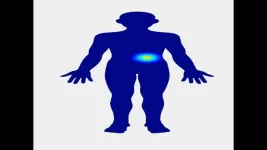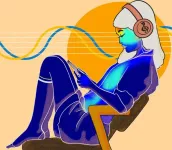(Press-News.org) It is possible to leave most of the lymph nodes in the armpit, even if one or two of them have metastases larger than two millimetres? This is shown in a trial enrolling women from five countries, led by researchers at Karolinska Institutet and published in the New England Journal of Medicine. The results open up for gentler surgery for patients with breast cancer.
Breast cancer can spread to the lymph nodes in the armpit. However, tumours found only in the breast and armpit lymph nodes are considered a localized disease, with the goal of curing the patient.
A challenging question for breast cancer surgeons revolves around what should be done when patients have metastases in the armpit, first detected during examination of tissue removed during surgery. Performing a so-called axillary dissection (removing many lymph nodes in the armpit) increases the risk of arm lymphedema. This occurs when lymph fluid cannot flow as freely as before, resulting in swelling in the arm and potentially causing pain and restriction of mobility.
"We want to perform less extensive procedures to spare patients from troublesome side effects. But we need to know that it's safe," says Jana de Boniface, breast cancer surgeon at Capio S:t Görans’s Hospital and researcher at the Department of Molecular Medicine and Surgery at Karolinska Institutet.
When it is known before the breast cancer surgery that there are metastases in the armpit, different treatment paths are chosen. Those patients are not included in this trial. However, when no lymphatic spread is suspected, the surgeon usually removes the so-called sentinel lymph nodes (the node or nodes first reached by lymph fluid from the breast). If these contain single tumour cells or metastases that are a maximum of two millimetres in size, the rest of the lymph nodes in the armpit are left intact. Previous trials have shown that this is safe for the patient.
Now, a large trial led from Karolinska Institutet has clarified the situation even for larger metastases. It includes nearly 2,800 patients from five different countries. All had metastases larger than two millimetres, so-called macrometastases, in one or two sentinel lymph nodes.
After sentinel node surgery, the patients were randomly assigned to undergo a completion axillary dissection (previously standard practice for all) or to leave the rest of the armpit undisturbed. Nearly all patients received some postoperative treatment with chemotherapy and/or anti-hormonal therapy, plus radiation therapy according to guidelines in each respective country. More than one-third of patients who underwent axillary dissection were found to have additional metastases than the maximum two in the sentinel lymph nodes. This must be assumed to be the same for those who kept the remaining lymph nodes. Still, recurrences were equally common in both groups, indicating that postoperative treatment seems sufficient to eliminate remaining tumour cells.
At the same time, a previous publication from the trial showed that 13 per cent of those who underwent axillary dissection reported serious or very serious problems with their arm function, compared to 4 per cent among those who only had the sentinel lymph nodes removed.
"Our assessment is that it is safe for patients to forgo axillary dissection if there are a maximum of two macrometastases in the sentinel lymph nodes. In these cases, axillary dissection is replaced with radiation therapy to the armpit, which results in less arm-related complications. This has now been implemented in clinical practice in Sweden," says Jana de Boniface.
The trial is called SENOMAC and is funded by grants from the Swedish Research Council, the Swedish Cancer Society, the Nordic Cancer Union, and the Swedish Breast Cancer Association.
Publication: “Omitting axillary dissection in breast cancer with sentinel node metastases”, Jana de Boniface, Tove Filtenborg Tvedskov, Lisa Rydén, Robert Szulkin, Toralf Reimer, Thorsten Kühn, Michalis Kontos, Oreste Davide Gentilini, Roger Olofsson Bagge, Malin Sund, Dan Lundstedt, Matilda Appelgren, Johan Ahlgren, Sophie Norenstedt, Fuat Celebioglu, Helena Sackey, Inge Scheel Andersen, Ute Hoyer, Per F Nyman, Eva Vikhe Patil, Elinore Wieslander, Henrik Dahl Nissen, Sara Alkner, Yvette Andersson, Birgitte Vrou Offersen, Leif Bergkvist, Jan Frisell, Peer Christiansen, New England Journal of Medicine, online April 3, 2024, doi: 10.1056/NEJMoa231348710.1056/NEJMoa2313487
END
Less extensive breast cancer surgery results in fewer swollen arms
2024-04-04
ELSE PRESS RELEASES FROM THIS DATE:
Body mapping links our responses to music with their degree of uncertainty and surprise
2024-04-04
Music holds an important place in human culture, and we’ve all felt the swell of emotion that music can inspire unlike almost anything else. But what is it exactly about music that can bring on such intense sensations in our minds and bodies? A new study reported in the journal iScience on April 4 has insight from studies that systematically examine the way perception of unique musical chords elicits specific bodily sensations and emotions.
“This study reveals the intricate interplay between musical uncertainty, prediction ...
Shaking tiny clusters of brain cells, scientists reveal an overlooked protein’s role in traumatic brain injury
2024-04-04
Clinicians often find limited success in treating patients with traumatic brain injury, a condition long linked to contact sports and military services. A new study, published April 4 in the journal Cell Stem Cell, may offer new clues to better solutions. Scientists found a protein, TDP-43, that appears to drive nerve damage right after injury. Moreover, blocking a certain cell surface protein can correct faulty TDP-43 and curb nerve death in mouse and human cells.
“There’s really nothing out there that can prevent the injury ...
Mistreatment in childbirth is common in the US especially among the disadvantaged
2024-04-04
Lack of respectful maternity care in the U.S. culminating in mistreatment in childbirth is a regular occurrence, according to a new study at Columbia University Mailman School of Public Health. Yet until now experiences of this mistreatment had not been widely documented in the United States. The findings are published in JAMA Network Open.
To estimate the prevalence of mistreatment by care providers in childbirth, the researchers collected survey data from a representative sample of people who had a live birth in 2020 ...
New findings shed light on the expanding universe
2024-04-04
An astrophysicist from The University of Texas at Dallas and his colleagues from the Dark Energy Spectroscopic Instrument (DESI) collaboration are at the forefront of an ambitious experiment to study the expansion of the universe and its acceleration.
Dr. Mustapha Ishak-Boushaki, professor of physics in the School of Natural Sciences and Mathematics (NSM) at UT Dallas, is a member of the DESI collaboration, an international group of more than 900 researchers from over 70 institutions around the world engaged in a multiyear experiment to increase understanding of the ...
Feeling the music
2024-04-04
Music which surprises us can be felt in the heart, while music which matches our expectations can bring feelings of calmness and satisfaction, according to a new study. Researchers played eight short tunes made up of just four chords each to over 500 participants. Each tune had a varied mix of surprising and unsurprising, and certain and uncertain chord progressions. When asked to report how the tunes made them feel and where they were affected, participants’ answers showed that fluctuations in predictions about chord sequences were felt in specific parts of the body, notably the heart and abdomen. Researchers also ...
Nerve stimulation for sleep apnea is less effective for people with higher BMIs
2024-04-04
A nerve-stimulation treatment for obstructive sleep apnea that originally was approved only for people with body mass indexes (BMIs) in the healthy range recently was extended to patients with BMIs up to 40, a weight range generally described as severely obese. A healthy BMI ranges from 18.5 to 24.9.
The expanded eligibility criteria for the treatment provide more sleep apnea patients with access to the increasingly popular therapy, known as hypoglossal nerve stimulation. However, new research from Washington University School of Medicine in St. Louis indicates that the likelihood of successful nerve-stimulation treatment ...
Severity of RSV vs COVID-19 and influenza among hospitalized US adults
2024-04-04
About The Study: Among 7,998 adults hospitalized during the 16 months before the first respiratory syncytial virus (RSV) vaccine recommendations, RSV disease was less common but similar in severity compared with COVID-19 or influenza disease among unvaccinated patients and more severe than COVID-19 or influenza disease among vaccinated patients for the most serious outcomes of invasive mechanical ventilation or death.
Authors: Diya Surie, M.D., of the Centers for Disease Control and Prevention in ...
Functional limitations and exercise intolerance in patients with post-COVID condition
2024-04-04
About The Study: In this randomized crossover clinical trial with 62 participants, non-hospitalized patients with post-COVID condition (PCC) generally tolerated exercise with preserved cardiovascular function but showed lower aerobic capacity and less muscle strength than the control group. They also showed signs of postural orthostatic tachycardia and myopathy. The findings suggest cautious exercise adoption could be recommended to prevent further skeletal muscle deconditioning and health impairment in patients with PCC.
Authors: Andrea Tryfonos, Ph.D., of the Karolinska Institutet in Stockholm, is the corresponding author.
To ...
Post-COVID not necessarily a barrier to exercise
2024-04-04
People suffering from post-COVID have been discouraged from exercising because early observations suggested it could be harmful. In a study published in JAMA Network Open, researchers from Karolinska Institutet show that post-covid does not mean that exercise must be strictly avoided.
People affected by post-COVID often experience symptoms such as extreme fatigue, shortness of breath, high resting heart rate, and muscle weakness. Symptoms are often exacerbated by exertion.
“The World Health Organization (WHO) and other major bodies have said that people with post-covid ...
Attack and defence in the microverse
2024-04-04
Viruses need hosts. Whether it’s measles, the flu or coronavirus, viral pathogens cannot multiply or infect other organisms without the assistance of their hosts’ cellular infrastructure. However, humans are not the only ones affected by viruses: animals, plants and even microorganisms can all serve as hosts. Viruses that use bacteria as host cells are called bacteriophages (or simply “phages” for short) and are thought to be the most abundant biological entities of all. Just as the human immune system springs ...




